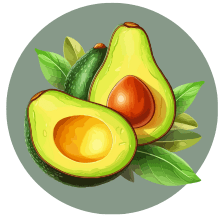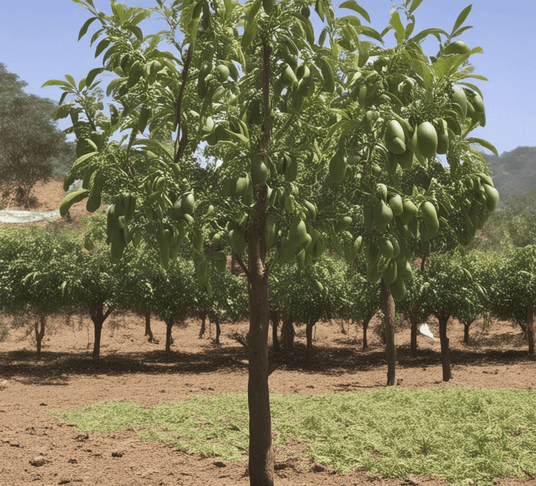How To Grow An Avocado Tree
–
The Complete Guideline
Last updated Nov. 29, 2023
Learn how to grow an avocado tree with our step-by-step expert guidelines.
in this new guide you will learn:
- How to plant an avocado tree
- How to grow a fast avocado tree
- How to care for avocado trees
- & Lot’s more
Chapter 1
Basic Information to Plant Avocado Tree
Chapter 2
Variety & Season to Plant Avocado Tree
Chapter 3
Soil Preparation for Planting Avocado Trees
Chapter 4
How to Plant an Avocado Tree
Chapter 5
How to Care for Your Avocado Tree
Chapter 6
Avocado Trees Diseases & Pest Management
Chapter 7
Harvesting & Storing Avocados
Chapter 1:
Planting Basics of Avocado Tree

How Long Does It Take to Grow an Avocado Tree?
Plant a tree, and bide your time for 3 to 4 years, that’s when fruit arrives. Sow a seed instead? Be ready for a longer pause. It might be 13 years, or perhaps even longer! Growing an avocado tree is a journey of patience and care.
Starting to grow an avocado tree is both thrilling and intriguing. One critical question frequently posed is: what’s the timeline? Understanding the growth process of an avocado tree is important for mapping out and savoring the eventual tasty fruits.
Are Avocado Trees Easy to Grow?
Yes and No. Pondering about welcoming an avocado tree into your yard? You might be curious if they’re simple to grow. They do require certain things, but with the right care, they can flourish!
Factors for Successful Growth:
- Sunlight and Climate: Avocado trees bask in sunny environments and require protection from strong winds.
- Soil Conditions: Well-draining soil is crucial for the health of the tree.
Regular Care: Like any plant, avocado trees need consistent care and attention, including proper watering and occasional pruning.
Here we written in depth about are avocado trees easy to grow? read this another blog post.
How Much Space Do I Need for an Avocado Tree?
Starting an avocado tree is like setting off on a green quest. It leads to leafy growth and, in time, picking your homegrown creamy avocados. But, before you start this adventure, there’s a key query to answer: How much space do i need for an avocado tree? Figuring out the spacing needs of avocado trees is key to their health, growth, and fruit-bearing. Let’s get into this to help your avocado trees grow to the best they can be.
Understanding Avocado Tree Sizes for Spacing
Avocado trees, much like apple trees, vary in size depending on the type. Here’s a look at the main categories and their space requirements:
Standard Avocado Trees:
These are the largest of the avocado varieties, potentially reaching up to 40 -60 feet in height and width.
They take several years to start bearing fruit but are known for their longevity and significant fruit production once mature.
Space Requirement: Plan for about 25-30 feet of space between each standard avocado tree.
Semi-Dwarf Avocado Trees:
These are a more manageable size and start bearing fruit sooner than standard trees.
Ideal for home gardens where space might be a bit more limited.
Space Requirement: These trees typically need about 15-20 feet between them.
Dwarf Avocado Trees:
Perfect for the smallest gardens or even suitable for container gardening on patios.
Dwarf varieties begin producing fruit relatively quickly and are easier to harvest due to their smaller size.
Space Requirement: They require the least space, approximately 8-10 feet between each tree.
Why Spacing Matters for Avocado Trees ?
Proper spacing is more than just ensuring your trees fit in your garden. Here’s why it’s important:
- Sunlight Access: Each avocado tree needs plenty of sunlight to flourish and produce fruit. Adequate spacing ensures every tree receives its share of sunshine, vital for growth and fruit development.
- Air Circulation: Good air circulation around avocado trees helps in preventing disease. Dense planting can lead to increased humidity, which is a breeding ground for fungal diseases and pests.
- Root Space: Avocado trees have expansive root systems. Proper spacing helps in preventing root competition, allowing each tree access to enough nutrients and water.
Maintenance and Harvesting Ease: Well-spaced trees are easier to maintain. There’s sufficient room for pruning, pest control, and at the time of harvest, picking the avocados becomes much more manageable.
Ideal Temperature For Avocado Trees
Selecting the right temperature for planting avocado trees is a crucial step towards ensuring healthy growth and abundant fruit production. Understanding the best temperature conditions for planting can set your avocado orchard or home garden up for success.
Why Temperature Matters for Avocado Trees?
The temperature at planting time plays a significant role in the early development of avocado trees:
- Root Development: Cooler but not cold temperatures are ideal for promoting healthy root growth in young avocado trees, without causing thermal stress.
- Avoiding Frost Damage: Planting after the risk of frost has passed is crucial, as frost can severely damage young avocado trees.
- Seasonal Preparation: Planting in the right temperature range allows avocado trees to establish themselves before facing the more extreme temperatures of summer or winter.
Ideal Temperature Range for Planting Avocado Trees
Avocado trees thrive in warm climates but require specific conditions for optimal planting:
- Best Planting Time: Late winter to early spring is generally the best time to plant avocado trees. This period allows the trees to establish a strong root system before the heat of the summer.
- Soil Temperature: The soil should be warm enough to encourage root growth but not hot. A good range is between 60°F to 75°F (15°C to 24°C). The soil should be workable and not chilled or frozen.
- Air Temperature: It’s also important to consider the air temperature. Consistently warmer days, typically above 60°F (15°C), indicate a safer environment for young avocado trees to be planted.
Regional Considerations for Planting Avocado Trees
- Location Variability: The ideal planting time for avocado trees can vary based on your geographic location. In regions with mild winters, late winter planting may be suitable, while in areas with colder climates, waiting until mid to late spring might be necessary.
Expert Advice: For the best local planting advice, consult with local nurseries, gardening clubs, or agricultural extension services familiar with avocado tree cultivation in your area
What Is The Meaning Of Type A and Type B On Avocado Planting
In avocado planting, the terms “Type A” and “Type B” refer to the two different categories of avocado flower types, which play a crucial role in pollination and fruit production. These designations help ensure successful avocado tree pollination and fruit set.
1. Type A Avocado Flowers:
- Type A avocado flowers open as female in the morning and then close during the afternoon.
- They reopen as male the following afternoon.
- This means that Type A flowers are functionally female in the morning and functionally male in the afternoon of the same day.
2. Type B Avocado Flowers:
- Type B avocado flowers open as female in the afternoon.
- They remain open as female during the following morning and then close during the afternoon.
- Type B flowers are functionally female in the afternoon and the morning of the next day.
Importance of Type A and Type B Flowers:
The presence of both Type A and Type B flowers on different avocado trees is crucial for successful pollination and fruit production. This reproductive strategy, known as “protogynous dichogamy,” helps ensure cross-pollination between avocado trees and increases the chances of successful fertilization.
When Type A and Type B avocado trees are planted in proximity, their flowers open at different times of the day, allowing for cross-pollination between the two types. This cross-pollination enhances fruit set and improves the overall yield of avocados.
In summary, Type A and Type B flowers in avocado planting refer to the timing of their receptivity to pollination. Ensuring that you have both types of avocado trees in your orchard or garden is essential for effective cross-pollination, leading to a higher avocado fruit production.
Where Is the Best Place to Plant an Avocado Tree?
Finding the best place to plant an avocado tree is like choosing a home – it needs to be just right.
Ideal Location to Plant an Avocado Tree :
The best location is a sunny spot with well-draining soil, sheltered from harsh winds.
If you’re in a cooler climate, a south-facing wall can provide extra warmth. Remember, these trees love the sun and thrive in favorable conditions.
Chapter 2:
Variety & Season to Plant Avocado Tree

Choosing the Right Avocado Variety
Choosing the right avocado tree variety for your garden, backyard, or orchard is crucial for a successful and satisfying harvest. Different avocado varieties vary in their flavor profile, climate preferences, disease resistance, and fruiting seasons. Here’s how to choose the best avocado variety for your needs:
1. Consider Your Local Climate:
Temperature Tolerance: Avocado trees generally prefer warm climates but vary in their cold tolerance. In cooler regions, choose cold-hardy varieties.
Heat Sensitivity: In extremely hot areas, consider varieties that can withstand intense heat.
2. Purpose of the Avocado:
Eating Fresh: If you prefer eating avocados fresh, look for varieties with creamy, rich textures and good flavor.
Culinary Uses: Some varieties have a higher oil content, making them ideal for cooking and making guacamole.
3. Disease Resistance:
Root Rot Resistance: Some avocado varieties are more resistant to root rot and other common diseases, which is crucial in areas where these issues are prevalent.
4. Pollination Requirements:
Type A and Type B Flowers: Avocado trees are classified as Type A or Type B based on their flowering patterns. For better fruit production, it’s ideal to have both types nearby for cross-pollination, although some varieties are self-fertile.
5. Local Advice:
Consult Experts: Speak with local nurseries, experienced gardeners, or agricultural extension services in your area for advice on the best varieties for your region.
6. Space and Growth Habits:
Tree Size: Consider the mature size of the tree. Standard varieties require more space, whereas dwarf varieties are suitable for smaller gardens or container planting.
7. Fruiting Time:
Harvest Season: Different avocado varieties bear fruit at various times of the year. Choose a variety that fits your desired harvest time.
8. Longevity and Yield:
Productive Lifespan: Some avocado trees yield fruit sooner but may have a shorter productive lifespan. Others take longer to mature but produce fruit for many years.
Selecting the right avocado variety involves balancing multiple factors, including climate suitability, intended use, and care requirements. By carefully choosing a variety that matches your environment and needs, you can enjoy a bountiful harvest of delicious avocados for years to come. Remember, local expertise is invaluable in making the best choice for your specific situation.
10 Avocado Varieties for Planting (Taste, Appearance, Fruiting Time, Why Choose)
1. Hass
- Taste: Creamy and rich flavor.
- Appearance: Medium-sized, pebbly skin that turns from green to purplish-black when ripe.
- Fruiting Time: Year-round, peak in spring and summer.
- Why Choose: The most popular variety globally, Hass avocados are versatile for various dishes and have a long shelf life.
2. Fuerte
- Taste: Smooth, creamy, and slightly nutty.
- Appearance: Larger, elongated fruit with smooth, thin skin.
- Fruiting Time: Winter through early spring.
- Why Choose: Great for cooler climates; the Fuerte is an excellent pollinator for other varieties and offers a different taste profile from Hass.
3. Bacon
- Taste: Light and subtle flavor.
- Appearance: Smooth, thin green skin with medium-sized fruit.
- Fruiting Time: Early winter.
- Why Choose: Cold-hardy variety suitable for cooler regions; Bacon avocados are ideal for salads due to their lighter flavor.
4. Gwen
- Taste: Rich and nutty, similar to Hass but slightly more intense.
- Appearance: Plump, round fruit with thick, pebbled skin.
- Fruiting Time: Spring and early summer.
- Why Choose: It offers larger fruit than Hass and is well-suited for growing in small spaces due to its compact tree size.
5. Zutano
- Taste: Lighter flavor, more watery than creamy.
- Appearance: Pear-shaped with shiny, thin green skin.
- Fruiting Time: Early fall through early winter.
- Why Choose: It’s one of the earliest varieties to fruit and is an excellent pollinator for Hass. Good choice for those who prefer a lighter flavor.
6. Reed
- Taste: Rich, creamy, and slightly nutty.
- Appearance: Large, round fruit with a thick green skin.
- Fruiting Time: Midsummer through fall.
- Why Choose: Reed avocados are known for their large size and excellent flavor. The trees are vigorous and productive.
7. Pinkerton
- Taste: Creamy and rich, similar to Hass.
- Appearance: Long, pear-shaped with pebbly green skin.
- Fruiting Time: Winter through spring.
- Why Choose: Pinkerton has a long fruiting season and its fruit has a high flesh-to-seed ratio, making it a great value.
8. Lamb Hass
- Taste: Similar to Hass but slightly less rich.
- Appearance: Large fruit with thick, pebbly skin.
- Fruiting Time: Late spring through early fall.
- Why Choose: Ideal for warmer climates, Lamb Hass trees are more vigorous and larger than regular Hass, extending the avocado season.
9. Sir Prize
- Taste: Bold and nutty.
- Appearance: Black, shiny skin with large, oval fruit.
- Fruiting Time: Winter.
- Why Choose: It’s a high-yielding variety with a shorter maturation period and is known for its excellent taste.
10. Sharwil
- Taste: Rich, nutty, and high oil content.
- Appearance: Medium-sized, oval fruit with rough green skin.
- Fruiting Time: Winter through spring.
- Why Choose: Popular in Australia, Sharwil is known for its excellent flavor and high oil content. It’s also a great pollinator for other varieties.
Each of these varieties has unique characteristics that make them a great choice depending on your taste preferences, climate conditions, and the specific requirements of your garden or orchard.
Best Season to Plant Avocado Tree
Timing is crucial when it comes to planting an avocado tree. The right planting season sets the stage for healthy growth and fruitful yields.
Ideal Planting Season:
- Spring Planting: The best time to plant an avocado tree is in the spring, particularly after the last frost. This timing allows the tree to establish itself during the warmer months.
- Climate Considerations: In regions with mild winters, you might also plant in the fall. However, spring remains the preferred season for most climates to ensure the young trees are not exposed to harsh winter conditions.
Getting an avocado tree to grow demands knowledge of its requirements and perfect timing. Picking the prime season and the correct seed-raising technique set the foundation for a rewarding gardening adventure. No matter if you’re skilled or a novice, these pieces of advice will aid you in embarking on your path to cultivating your personal avocado tree.
Chapter 3:
Soil Preparation for Planting apple Trees

Understanding the Importance of Soil Preparation
Preparing the soil is like setting a strong foundation for your avocado tree. It’s not just about planting; it’s about creating the ideal environment for your tree to thrive. Good soil preparation ensures your avocado tree gets the best start possible.
Why Soil Preparation Matters:
Nutrient-Rich Environment: Avocado trees require nutrient-dense soil to grow and produce fruit effectively.
Proper Drainage: These trees are particularly sensitive to waterlogged conditions, so ensuring well-draining soil is essential.
Root Growth: Well-prepared soil facilitates better root penetration and expansion, vital for the tree’s overall health.
Soil Preparation for Planting apple Trees
Creating the perfect home for your avocado tree involves several key steps:
- Test the Soil: Start by testing the soil’s pH and nutrient levels. Avocado trees prefer slightly acidic to neutral soil (pH 6 to 7).
- Choose the Right Spot: Pick a location that gets plenty of sunlight and is protected from strong winds.
- Amend the Soil: Based on the soil test, amend the soil with the necessary nutrients. Organic matter like compost or well-rotted manure can improve soil structure and fertility.
- Ensure Drainage: If your soil is heavy and retains water, consider elevating the planting area or incorporating gritty material to enhance drainage.
- Digging the Planting Hole: When you’re ready to plant, dig a hole that is as deep as the root ball and twice as wide. This gives the roots plenty of room to expand.
Final Thoughts on Soil Preparation
Getting the ground ready for your avocado plant may feel burdensome, but it’s a vital task that mustn’t be ignored. By investing the time to yield the perfect soil environment, you’re lending your avocado tree the optimal opportunity for a sturdy and fruitful existence. Keep in mind, the labor invested in ground conditioning will reap rewards when you’re savoring tasty avocados harvested from your own garden!
Chapter 4:
How to Plant an Avocado Tree

How to Grow an Avocado Tree from Seed?
Growing an avocado tree from a seed is a rewarding journey that begins in your very own kitchen. This process is not only a fascinating gardening project but also an educational experience, especially if you’re trying it for the first time.
Steps to Grow from Seed:
- Select a Seed: Choose a fresh avocado seed from a ripe avocado.
- Seed Sprouting: Clean the seed and use the toothpick method to suspend it over a water-filled container. The bottom part of the seed should be submerged.
- Wait for Germination: Place it in a warm, sunny spot and change the water regularly. It can take a few weeks to sprout.
- Planting: Once the sprout reaches about 6 inches, plant it in a pot with well-draining soil.
Growing Phase: Provide your growing avocado tree with plenty of sunlight, regular watering, and patience as it develops.
10 Steps Guide to Planting Your Avocado Tree
Planting an avocado tree is an exciting milestone in your gardening journey. This step-by-step guide is designed to help you plant your tree correctly, ensuring it gets the best start in its new home.
1. Choosing the Right Tree:
Select a healthy young avocado tree from a nursery. Look for a tree with vibrant, green leaves and a sturdy stem.
2. Timing:
Plant your avocado tree in the spring, after the danger of frost has passed. This gives the tree a full growing season to establish itself.
3. Preparing the Site:
Choose a sunny spot with well-draining soil. Clear the area of weeds and other debris.
4. Digging the Hole:
Dig a hole as deep as the root ball and twice as wide. This provides enough room for the roots to expand.
5. Removing the Tree from the Container:
Gently remove the tree from its container. Be careful not to disturb the root ball too much.
6. Placing the Tree:
Place the tree in the center of the hole. The top of the root ball should be level with the soil surface.
7. Filling the Hole:
Fill the hole with soil, gently tamping it down around the roots to remove air pockets.
8. Watering:
Water the tree thoroughly after planting. This helps settle the soil and ensures the roots have enough moisture.
9. Mulching:
Apply a layer of mulch around the base of the tree to conserve moisture and regulate soil temperature.
10. Staking (If Necessary):
If your tree is tall or in a windy area, you might need to stake it for support.
Aftercare Tips
- Regular Watering: Avocado trees need consistent watering, especially during the first few years after planting.
- Monitoring Growth: Keep an eye on your tree’s growth and health. Look out for signs of pests or diseases.
- Pruning: Prune your avocado tree if necessary to encourage growth and fruit production.
Chapter 5:
How to Care for Your Avocado Tree

Post-Planting And Mature Avocado Tree Care
Maintaining a cheerful avocado tree requires more than sporadic watering. It’s understanding and meeting the tree’s needs during every stage of its life. This segment provides an all-inclusive guide on how to care for avocado trees. From the moment they’re planted to the time they reach maturity, it’s crucial for their growth and plentiful yield.
Post-Planting Care for Avocado Trees
- Watering: Newly planted avocado trees need consistent watering to establish their roots. Water deeply once a week, ensuring the soil is moist but not waterlogged. Avocado trees are particularly sensitive to over-watering, so it’s important to let the soil dry out slightly between waterings.
- Mulching: Apply a layer of organic mulch around the base of the tree to help retain soil moisture and suppress weeds. Keep the mulch a few inches away from the trunk to prevent moisture buildup around the base, which can lead to rot.
- Staking: Stake the tree if it’s located in a windy area or if the trunk shows signs of weakness, to provide necessary support as it grows.
- Pruning: Light pruning may be needed to shape the young tree and remove any damaged or diseased branches. However, avocado trees generally require less pruning compared to apple trees in their early years.
- Protection: Protect the young tree from pests and diseases using appropriate barriers, traps, or organic treatments. Be vigilant about signs of root rot, a common issue in avocado trees.
Mature Avocado Tree Care
- Regular Pruning: Annually prune your avocado tree in the early spring. Focus on removing dead or diseased wood and opening up the tree’s canopy for better light and air flow.
- Pest and Disease Monitoring: Keep an eye out for common avocado pests and diseases. Regularly inspect the tree and treat with appropriate methods if necessary.
- Fruit Thinning: Unlike apple trees, avocado trees do not usually require fruit thinning. However, if the tree is overproducing, some thinning can help improve fruit size and quality.
- Watering Adjustments: Mature avocado trees still need regular watering but can withstand slightly longer periods between waterings. Ensure deep watering, especially during extended dry periods.
- Soil Health and Fertilization: Check the soil’s nutrient levels regularly. Use a balanced fertilizer tailored for avocado trees. Both commercial and homemade organic fertilizers can be beneficial. Apply fertilizers during the growing season for best results.
Regular Watering and Moisture Management
Water is essential for avocado trees, but they don’t like to have “wet feet.” Here’s how to get it right:
- Frequency: Water young trees 2-3 times a week. Mature trees need watering 1-2 times a week, depending on the weather.
- Method: Deep watering is better than frequent light watering. This encourages deeper root growth.
- Moisture Check: Use a soil moisture meter or stick your finger into the soil. If it’s dry a few inches down, it’s time to water.
Fertilizing Your Avocado Tree
Fertilizing an avocado tree is important for its health and fruit production. You can use both commercial and homemade fertilizers to nourish your avocado tree. Here’s how to do it without any commas:
Commercial Fertilization
Choose the Right Fertilizer:
Select a balanced fertilizer specifically designed for fruit trees. Look for an N-P-K (Nitrogen-Phosphorus-Potassium) ratio suitable for avocados, like 10-10-10 or 20-20-20.
Timing:
The best time to fertilize avocado trees is in early spring before bud break. This helps the tree during its most active growth phase.
Application:
Read and follow the instructions on the fertilizer package for the correct application rate. Spread the fertilizer evenly over the soil surface, starting about a foot from the trunk and extending to the drip line (the outer edge of the tree’s canopy). Avoid applying fertilizer directly against the trunk as this can cause burn damage.
Watering:
Water the tree thoroughly after applying the fertilizer. This helps to distribute the nutrients into the soil and prevents root burn.
Regular Monitoring:
Observe your tree’s growth and health. Over-fertilizing can be as harmful as under-fertilizing, so adjust your practices based on the tree’s response.
Homemade Fertilization
Making Compost and Using Compost:
Create a compost pile with kitchen scraps (like fruit and vegetable peels), lawn clippings, leaves, and other organic matter. Allow it to decompose until it’s dark and rich in texture.
Spread a layer of compost around the base of the tree, extending to the drip line. This not only adds nutrients but also improves soil structure and moisture retention.
Eggshells:
Rinse and dry eggshells, then crush them into small pieces. They provide calcium, which is essential for cell growth in avocado trees.
Coffee Grounds:
Used coffee grounds add nitrogen, a key nutrient for leaf and stem growth. Mix grounds into the soil around the tree or add them to your compost.
Banana Peels
Cut banana peels into small pieces and bury them in the soil around the tree or add them to your compost. Banana peels are rich in potassium, crucial for fruit development.
Wood Ash
If you have a wood-burning stove or fireplace, wood ash can be a good source of potassium and calcium. Sprinkle a small amount around the base of the tree, but use it sparingly as it can affect soil pH.
General Tips
Balanced Approach: Whether using commercial or homemade fertilizers, the key is to maintain a balanced approach.
Soil Testing: Periodic soil testing can provide insights into nutrient levels and help tailor your fertilization strategy.
Observation: Regularly observe your tree’s health and growth, and adjust your fertilization practices as needed.
Applying the correct quantity and kind of fertilizer, either store-bought or DIY, greatly assists your avocado tree’s well-being and fruit output. Remember, the goal is to boost the tree’s growth and fruit production without overdoing it.
Pruning for Health and Productivity
Pruning is essential for tree health and fruit production. Here’s how to do it:
- Best Time to Prune: Late winter or early spring, before new growth begins.
- Goal of Pruning: Remove dead or diseased wood, open up the canopy for better light penetration, and maintain the tree’s shape.
- Technique: Use clean, sharp tools. Make clean cuts close to the trunk or main branch.
Pest and Disease Management
Avocado trees can be susceptible to pests and diseases. Stay vigilant:
- Common Pests: Look out for aphids, mites, and borers.
- Disease Watch: Root rot and fungal infections are common issues.
- Control Measures: Use appropriate organic or chemical treatments as needed. Consult with a local nursery or agricultural extension office for advice.
Mulching and Soil Health
Mulching helps maintain soil health and moisture levels:
- Mulch Material: Use organic mulch like wood chips or straw.
- Application: Spread a 2-3 inch layer around the base of the tree, keeping it a few inches away from the trunk.
- Benefits: Mulch helps conserve water, adds nutrients as it decomposes, and regulates soil temperature.
Monitoring and Adjusting Care
Every avocado tree is unique. Monitor your tree and adjust care as needed:
- Visual Inspection: Regularly check for signs of stress, such as yellowing leaves or stunted growth.
- Adapt Watering and Fertilizing: Adjust based on the tree’s response and seasonal changes.
- Consult Experts: Don’t hesitate to seek advice from gardening forums, local nurseries, or agricultural extensions.
Chapter 6:
Avocado Trees Diseases & Pest Management

Understanding the Significance
Pests and diseases in avocado trees can have significant consequences, both for commercial growers and home gardeners. These issues can:
- Reduce Yield: Infestations and infections can lead to reduced fruit production, affecting the quantity and quality of avocados.
- Economic Impact: For commercial growers, pest and disease management is crucial to protect their livelihoods and investments in avocado cultivation.
- Environmental Impact: The use of pesticides and chemicals to combat pests and diseases can have environmental implications, making sustainable management practices essential.
6 Common Avocado Tree Diseases
Diseases can significantly affect the health and productivity of avocado trees. Here’s what to look out for and how to handle them:
Root Rot (Phytophthora cinnamomi):
- Symptoms: Yellowing leaves, stunted growth, branch dieback.
- Management: Ensure good drainage, use resistant rootstocks, and apply fungicides if recommended by local experts.
Anthracnose (Colletotrichum gloeosporioides):
- Symptoms: Dark, sunken spots on fruit and leaves.
- Management: Maintain tree hygiene, prune to improve air circulation, and apply appropriate fungicides.
Canker Diseases:
- Symptoms: Sunken, dark areas on branches or trunk.
- Management: Prune affected areas, avoid wounding the tree, and apply copper-based fungicides as a preventive measure.
Avocado Sunblotch Viroid (ASBVd):
- Symptoms: Yellowed, mottled, or streaked leaves, stunted fruit growth, and reduced yield.
- Management: There’s no cure for ASBVd, so prevention is critical. Use disease-free planting material and sanitize pruning tools.
Leaf Spot (Cercospora purpurea):
- Symptoms: Circular, dark spots with yellow halos on leaves.
- Management: Keep foliage dry, ensure good air circulation, and use fungicides if necessary. Remove and destroy fallen leaves.
Scab (Sphaceloma perseae):
- Symptoms: Rough, scab-like lesions on fruit and leaves.
- Management: Apply sulfur-based fungicides, especially during wet weather. Maintain good tree hygiene and prune to improve air circulation.
We already covered in depth knowledge about 10 Avocado Tree Diseases
6 Common Avocado Tree Pests
Pests can be detrimental to avocado trees, but early detection and treatment can mitigate their impact.
Avocado Lace Bug (Pseudacysta perseae):
- Symptoms: Yellow, mottled leaves, and black, tar-like excrement on the underside of leaves.
- Management: Use insecticidal soaps or oils, encourage natural predators, and remove severely infested leaves.
Persea Mite (Oligonychus perseae):
- Symptoms: Yellow or bronzed leaves, webbing on the underside of leaves.
- Management: Apply miticides if necessary, promote natural predators, and maintain tree health to reduce susceptibility.
Borers:
- Symptoms: Entry holes in the trunk, sawdust-like frass.
- Management: Keep trees healthy to resist borers, prune out infested branches, and consider chemical controls if infestation is severe.
Snails and Slugs:
- Symptoms: Irregular holes in leaves and fruit, slimy trails.
- Management: Use snail baits or traps, remove hiding places, and encourage natural predators like birds.
Scale Insects:
- Symptoms: Sticky honeydew on leaves, clusters of small, bumpy insects on branches.
- Management: Apply horticultural oil or insecticidal soap, prune heavily infested areas, and encourage natural enemies.
Avocado Thrips (Scirtothrips perseae):
- Symptoms: Scarring on fruit surface, distorted and stunted leaves.
- Management: Use reflective mulch to deter thrips, apply approved insecticides, and promote natural predators.
Integrated Pest Management (IPM)
Implementing an IPM approach can be effective in controlling pests and diseases:
- Monitor Regularly: Regular inspections help in early detection of problems.
- Cultural Controls: Maintain tree health, sanitation, and proper pruning practices.
- Biological Controls: Encourage or introduce natural predators and beneficial insects.
- Chemical Controls: Use chemical treatments as a last resort, following safety guidelines and local regulations.
Preventive Measures
Prevention is always better than cure:
- Plant in Suitable Locations: Choose sites with good drainage and sunlight.
- Resistant Varieties: Opt for varieties known to be resistant to common diseases and pests.
- Soil Health: Keep the soil healthy with organic matter and appropriate fertilization.
Here is the article about 10 Common Pests of Avocado Trees.
Chapter 7:
Harvesting & Storing Avocados

How to Know When Avocados are Ready to Harvest
Color Change:
Look for a change in the avocado’s skin color from green to a darker shade, which is often a sign of ripeness. However, this varies depending on the avocado variety.
Texture:
Gently squeeze the avocado. A ripe avocado should yield slightly to gentle pressure without being too soft. If it’s too hard, it needs more time to ripen. If it’s mushy, it may be overripe.
Stem Test:
Remove the small stem or cap at the top of the avocado. If it comes off easily and is green underneath, the avocado is likely ripe. If it’s brown, it may be overripe.
Proper Harvesting
Gentle Handling:
Handle avocados gently to avoid bruising. Bruised avocados can deteriorate quickly and affect others in storage.
Twist and Lift:
Use the twist-and-lift method to harvest avocados. Gently twist the fruit while lifting it upwards to detach it from the tree.
Harvesting Tools:
For hard-to-reach avocados, consider using a pole or a fruit picker with a soft basket to prevent damage during harvest.
Inspect for Damage:
Examine each avocado as you pick. Set aside any with cuts, bruises, or signs of insect damage for immediate use.
Storing Process
-
Ideal Conditions:
- Store avocados in a cool, dry place. Optimal storage temperatures are around 50°F (10°C). Avoid exposing avocados to extreme cold or heat.
-
Ripening Process:
- If you need to ripen avocados, place them in a paper bag with a banana or apple. These fruits release ethylene gas, which speeds up the ripening process.
-
Refrigeration:
- Once avocados are ripe, you can store them in the refrigerator to extend their shelf life. Place them in the crisper drawer.
- Check Regularly:
- Inspect stored avocados regularly and remove any that show signs of overripening or decay to prevent them from spoiling others.
-
Avoid Crowding:
- Keep avocados separate from other produce in the fridge. They also produce ethylene gas, which can affect the ripening of nearby fruits and vegetables.
-
Use Plastic Wrap
- If storing cut avocados, cover the exposed flesh with plastic wrap to minimize exposure to air, which can cause browning.
Harvesting avocados at the right time and storing them under the proper conditions are essential for enjoying the best quality fruit. Different avocado varieties have different storage capabilities, so it’s important to understand the specific needs of your avocados. With the right harvesting and storage techniques, you can maximize the freshness and longevity of your avocados.











